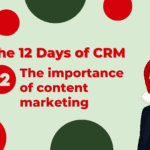Need to Do More with Less? Focus on CRM Success

This article first appeared in Law Journal Newsletter on March 1st, 2024.
Less Isn’t Just More… It’s Everything
Marketing teams have heard so many times: do more with less – and 2024 is no different. According to new research, in 2023 law firm marketing budgets shrank1 even though revenue grew by 4.6%2 – and yet the demands on the marketing department actually increased. (Shocking, I know.)
At the same time approximately 50% of buyers said that they are looking to replace their existing law firms3, resulting in more pitches, more proposals, more RFPs – and more hours of work for Marketing and BD teams.
Add to the mix more competitors that now include an array of mid-size law firms, boutique and specialty firms, accounting firms, new law companies and well-funded alternative legal services providers. All this means more pressure on the Marketing department to differentiate their firm’s brand and enable strategic, effective business development programs – but with less budget and staff.
In this era of more with less, marketers desperately need tools to fill in the gaps between more and less. One potential tool should be the firm’s CRM.
CRM to the Rescue – or Rescue the CRM?
CRM is foundational to the success of Marketing and BD teams because it is precisely the tool that allows the firm to efficiently manage and nurture client and prospect relationships… but there is an ongoing – and growing – disconnect across firms related to the technology.
According to the 2023 Thomson Reuters Marketing Partner Forum Survey, of all the tools in the marketing mix, CRM was considered one of the two “least effective.” In 2024, it hit rock bottom ranking “not effective at all.”
As a CRM success consultant for nearly twenty years, I’m not shocked by this. We’ve known for quite some time that nearly 70% of all CRM implementations fail – and if your firm has a failed implementation, you’re not going to rank it as effective. (Again, shocking, I know.)
Here’s the thing: a successful CRM implementation, supported by the right strategy and plan, can actually provide significant value to Marketing and Business Development teams and ultimately enhance firm growth and revenue. The operative word: successful.
Additionally, CRM is one of the most important tools that marketers need to consider – or reconsider – as the tool that has the ability to create substantial efficiencies and streamline previously labor-intensive processes. (Aka more with less.) CRM can also provide business developers with valuable insights and information to help them identify and target the best opportunities. It can help practice, industry and client teams identify relationships and better manage strategic objectives. It can help track return on investments related to events, sponsorships and contributions, allowing a more objective assessment of the value of BD and Marketing activities.
So what can firms do to be more successful with CRM? Having worked together with literally hundreds of firms to help them achieve CRM success, here are our top 3 suggestions.
Select the Right System
Embracing CRM as a strategy starts with an assessment of your firm’s unique goals, needs and requirements. Then it’s important to evaluate your system. This is why so many firms are currently replacing older CRM systems with new cloud-based and business-development-focused technology that can meet their ever-changing needs.
CRM selection should focus on topics that are business-critical such as:
- Solving problems
- Automating processes
- Identifying relationships
- Improving communication, coordination and client service
- Increasing efficiency
- Identifying opportunities
- Enhancing business development – and ultimately increasing revenue
Create a Demonstration Roadmap
Once your key goals and needs have been identified, matching the organization’s most important requirements to a specific technology becomes a simpler and more manageable proposition. An important part of the technology selection process often involves sitting through demonstrations of myriad features and functions of various systems. But resist the temptation to do this too soon as it’s easy to get caught up in the bells and whistles during these presentations and lose sight of your goals. Remember, problems first… then products.
The best way to do this is to translate your assessment of the firm’s goals, needs and requirements into a “demonstration roadmap” that is used to guide presenters to focus on only the requirements and needs the firm has identified, rather than bells and whistles that won’t provide value to your firm or professionals and often end up increasing the project budget.
Balance Integrations with Cost and Benefits
Integrating other systems can also increase system value, creating a powerful engine to drive firm growth. However, integrations can be costly in terms of money and time, so performing a cost-benefit assessment for each integration is extremely important. Here are some potential points of CRM integration to consider:
- Enterprise Relationship Management (ERM) Systems to identify relationship connections and strengths, create contacts from the signature blocks of emails and minimize time spent on data stewarding
- Email Marketing / Marketing Automation Systems to quickly and easily generate lists, distribute communications, track related activities, capture subscriptions and facilitate the flow of information and analytics related to campaigns
- Event Management Technology to send invitations, collect RSVPs, create related activities and measure ROI
- Time & Billing Systems to identify clients and top clients, relationship attorneys, revenue trends and opportunities for cross-selling
- Pipeline Management Tools to track opportunities and activities to track and improve business development success rates
- Human Resource Information Systems to automatically create system users and publish and update firm directories
While all of these endeavors sound great, before jumping into a decision about any integration, the pros and cons should be carefully weighed. The costs of an overly ambitious or aggressive integration strategy can easily outweigh the benefits, especially if the data sets in both systems are not well maintained, which is an all-too-common problem in many firms. Additionally, it’s important to check references from other firms that have done the integration before to ensure that you don’t end up inadvertently paying to be a “beta client” for a new or untested integration, as these projects can cost more and take longer than expected.
Next Steps for Success
Without a solid strategy, the risk that CRM will fail to meet expectations increases dramatically and can result in a significant loss of time, money – and credibility. But following a few simple steps can greatly improve the odds of success:
- Involve key stakeholders and system users early and often throughout the assessment, planning, selection and implementation processes
- Asses critical needs and requirements before software selection
- Focus on needs and requirements, not bells and whistles
- Pay close attention to change management challenges
- Assess the costs and benefits of possible system integrations
- Dedicate necessary required resources including time, money and people
Most importantly… don’t do it alone. Reach out for help from peers and colleagues, technology providers or consultants who can share information, ideas and best practices for success gathered from hundreds of similar implementations.
About Chris Fritsch, J.D.
Chris Fritsch is the founder and president of CLIENTSFirst Consulting, the legal industry’s leading consultancy helping firms achieve success and ROI with the selection and implementation of technology such as Customer Relationship Management (CRM) and eMarketing as well as enhancing Data Quality.
Chris writes and speaks frequently at the industry’s most important legal marketing, and business development technology events on a variety of topics including CRM, eMarketing and data quality. Email Chris at: CF@CLIENTSFirstConsulting.com






